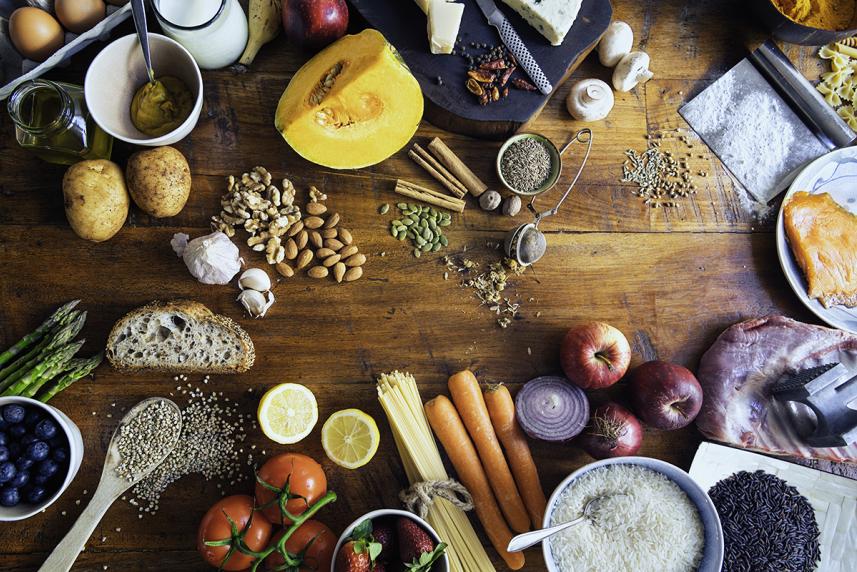Beyond calcium: The best nutrients for healthier bones — and where to get them
These vitamins and minerals are just as important as calcium for building and maintaining strong bones.

Your bones support you — literally — in a lot of ways. In addition to keeping you upright, they protect your organs and are a storage site for minerals that your body needs to function properly.
But according to the Centers for Disease Control and Prevention, more than half of women (and about a third of men) over 50 have low bone mass. That puts them at higher risk of falls and osteoporosis, a disease that weakens bones. Osteoporosis is a leading cause of bone fractures — especially hip fractures — in older adults.
That’s why it’s vital to support your bones as much as they support you. Eating a healthy diet as you age can provide the nutrients your body needs to maintain strong bones. You probably already know that calcium — a mineral found in dairy and other foods — is a key part of the equation. But there are lots of other nutrients that support bone health, too.
To learn what they are and how to add them to your diet, keep reading.

Call your primary care provider to schedule an appointment. If you don’t have a PCP, you can use Find a Doctor on hmsa.com to search for a participating provider near you.
Essential nutrients (besides calcium) for bone health
Many other nutrients work with calcium to build strong bones. Here are some important ones.
Phosphorus: Calcium and phosphorus combine to make hard crystals that give bones their solid structure. Good sources of phosphorus include dairy, meat, shellfish, and beans.
Vitamin C: This vitamin helps your body produce collagen. Collagen is a soft material that makes up the framework of the bone matrix (that’s what gives bones their mass). Vitamin C is found in many fruits and vegetables, especially citrus, bell peppers, and tomatoes.
Vitamin D: Your body needs vitamin D to absorb calcium from food, according to the American Academy of Orthopaedic Surgeons. There aren’t too many food sources of vitamin D, but many dairy foods, such as milk, have vitamin D added to them.
Your skin can make vitamin D when you’re exposed to the sun. To get the vitamin D you need, spend five to 15 minutes in the sun a few times a week — without sunscreen.
Vitamin K: Bone is a living organ that’s constantly being broken down and rebuilt. Vitamin K is essential for those processes. Dark leafy greens such as kale, watercress, and spinach are sources of vitamin K.
Magnesium: This is another mineral found in bone structure. Magnesium strengthens the calcium and phosphorus crystals. Sources of magnesium include nuts and seeds, avocado, and chickpeas.
Potassium: Getting enough potassium may help prevent the loss of calcium through your urine. Eating plenty of fruits and vegetables will help you get the potassium you need. Potatoes, bananas, oranges, and dried fruit are particularly good sources.
Best foods to eat for strong bones
You can get these bone-supporting nutrients from eating a balanced diet. Fill your plate with a variety of foods from different food groups, including plenty of dairy.
If you’re looking to “bone up” your diet even more, include some of the following foods:
Prunes: Eating five to six prunes a day could help slow bone loss and maintain bone density in older women, according to a 2022 study. Prunes are a good source of potassium, magnesium, and vitamin K.
Green leafy vegetables: Dark green leafy vegetables such as kale, watercress, and mustard greens are good sources of vitamin K. They’re also a plant-based source of calcium.
But some greens, such as spinach and beet greens, are high in compounds called oxalates, which can block calcium absorption. You don’t need to avoid these greens, according to the Bone Health and Osteoporosis Foundation. They’re a good source of vitamin K, magnesium, and vitamin C. Just keep in mind that they won’t be a good source of calcium.
Oranges and orange juice: Citrus is a good source of vitamin C and potassium. Plus, many bottled orange juices are fortified with calcium and vitamin D, making them just as good as milk for bone health.
Salmon: Fatty fish such as salmon, mackerel, tuna, and sardines are good sources of vitamin D. Canned fish with bones is also a good way to get calcium. Fatty fish also contain omega-3 fatty acids, which recent research shows may boost bone health.
Keep bones healthy and strong by limiting these foods
There are some foods that can get in the way of healthy bone formation. To keep your bones strong, you may want to limit these foods and drinks:
- Salty foods: Too much sodium can cause your body to lose calcium, leading to weaker bones. Packaged and restaurant foods are the biggest sources of sodium in Americans’ diets. To reduce your sodium intake, cook more meals at home and choose packaged foods with reduced sodium.
- Coffee and tea: Caffeine may block calcium absorption and contribute to bone loss. Stick to less than three cups of coffee or tea a day. To boost your calcium, add milk to your cup.
- Soft drinks: Sodas, particularly colas, may contribute to bone loss because they’re high in caffeine and phosphorus. Phosphorus is an important mineral for bone structure, but too much may be harmful, especially if you don’t get enough calcium.
- Alcohol: Regularly having more than two alcoholic drinks a day can raise your risk of osteoporosis, according to the Mayo Clinic.
Know your risk of osteoporosis
Talk to your doctor about your bone health and risk of osteoporosis, especially if you’re a woman. Women experience a sharp decline in bone density during menopause, increasing the chance of osteoporosis as they age.
The U.S. Preventive Services Task Force recommends that women be screened for osteoporosis at age 65. You might want to get screened even sooner if your doctor thinks you’re at higher risk.
The good news is that it’s never too late to focus on strong bones. Taking action now can help prevent health issues down the line and let you stay active for years to come.
Additional sources:
Low bone mass statistic: Centers for Disease Control and Prevention
Hip fracture: Centers for Disease Control and Prevention
Vitamin D and calcium: American Academy of Orthopaedic Surgeons
Plums and bone mass: American Journal of Clinical Nutrition
Leafy greens: Bone Health and Osteoporosis Foundation
Alcohol: Mayo Clinic
Osteoporosis screenings: U.S. Preventive Services Task Force
H3832_8750_5MS550_24_C
© 2023, Linkwell Health, Inc. All content owned or licensed by Linkwell Health, Inc. All rights reserved.


